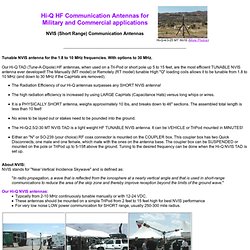

NVIS Antenna. Set up is simple.

A 3’ piece of pipe is driven half way into the ground. The PVC Tee with the dipole is slipped on top of two sections of mast, and the mast is slipped over the pipe. The dipole is unreeled and stretched out. Two more pipes are driven a couple of feet past the ends of the dipole and two sections of mast are put over each one. The dipole ends are tied to the ends of the mast with string. Most of the literature shows the NVIS using 3 reflector wires. The wires are about 4’ longer than the dipole. Operation Skywave propagation requires a minimum level of ionization in order for the ionosphere to direct the signals back to earth.
I found the NVIS antenna to be a useful addition for FD. EMCOMM / NVIS Tools. The article "An Illusion of Secrecy" by Larry Randall was serialized in "Public Safety Communications Magazine".

It serves as a good primer for those interested in encryption, and for those interested in data transmission over radio channels. The article is written to a non-technical audience that has a requirement to grasp the issues and constraints encountered when applying encryption to various communications media, Please read the "Note to Reader". AN ILLUSION OF SECRECY:An_Illusion_of_Secrecy.pdf EMCOMM / NVIS Tools As part of our owner's long-time personal commitment to emergency preparedness and emergency management, we also offer education and tools related to Emergency Communications, Disaster Response, and Emergency Preparedness.
Larry Randall is available as a speaker for civic organizations, disaster preparedness groups, emergency management and communications groups, and amateur radio organizations. VOACAP Path Analysis Tools RIGHT CLICK the links below and select SAVE AS: 75/60/40 Meter NVIS Portable Antenna. 75/60/40 Meter NVIS Portable Antenna Stephen T.

Reynolds (W4CNG) on July 6, 2003 View comments about this article! NVIS Antennas for 75/60/40 Meters By Stephen Reynolds W4CNG A.R.E.S. This article describes an antenna support mast, and a 3 band antenna system just right for A.R.E.S. or other In-Field Deployment. The top section of the antenna is seen on the left with 4 additional 34 inch supports. Simplicity in design was the first thing, with a cost of less than $20 for the PVC pipe, and $4 worth of #14 stranded wire. Hi-Q-Antennas: Military, Government, NVIS, and Commercial HF Radio Mobile Operation KEYWORDS: W6HIQ, portable, HF mobile antennas, mobile antenna, screwdriver antenna, dipole.
Tunable NVIS antenna for the 1.8 to 10 MHz frequencies.

With options to 30 MHz. Our Hi-Q TAD (Tune-A-Dipole) HF antennas, when used on a Tri-Pod or short pole up 5 to 15 feet, are the most efficient TUNABLE NVIS antenna ever developed! The Manually (MT model) or Remotely (RT model) tunable High "Q" loading coils allows it to be tunable from 1.8 to 10 MHz (and down to 30 MHz if the CapHats are removed). The Radiation Efficiency of our Hi-Q antennas surpasses any SHORT NVIS antenna! The high radiation efficiency is increased by using LARGE CapHats (Capacitance Hats) versus long whips or wires. "In radio propagation, a wave that is reflected from the ionosphere at a nearly vertical angle and that is used in short-range communications to reduce the area of the skip zone and thereby improve reception beyond the limits of the ground wave.
" Our Hi-Q NVIS antennas: Typically from 2-10 MHz continuously tunable manually or with 12-24 VDC. Click for Photo Gallery Copyright 2003, All Rights Reserved. N.V.I.S. Portable Antenna. Nicely done.

Although, for 100-250 mi coverage on 80/40 meters from the mobile station, I've done something for many years that's far simpler. The only requirement is a well-placed mobile "ball" mount, the mount, a stainless steel spring, an insulated windshield clip, cheapie mobile antenna tuner (MFJ-945E or equivalent) and 102" stainless steel "CB" whip. This antenna can be used while driving, or parked, equally well and is self-contained to the vehicle. Install ball mount on rear fender (L or R) of the car. Install antenna spring into ball mount, and CB whip into spring. Transmit, and tune for a match. I use something like this, but with an SGC-230 Autotuner so I can easily change bands without manually adjusting anything, and it's like having a mobile NVIS antenna. The wire antenna shown here probably works better, but my approach works while you're going 75 mph!